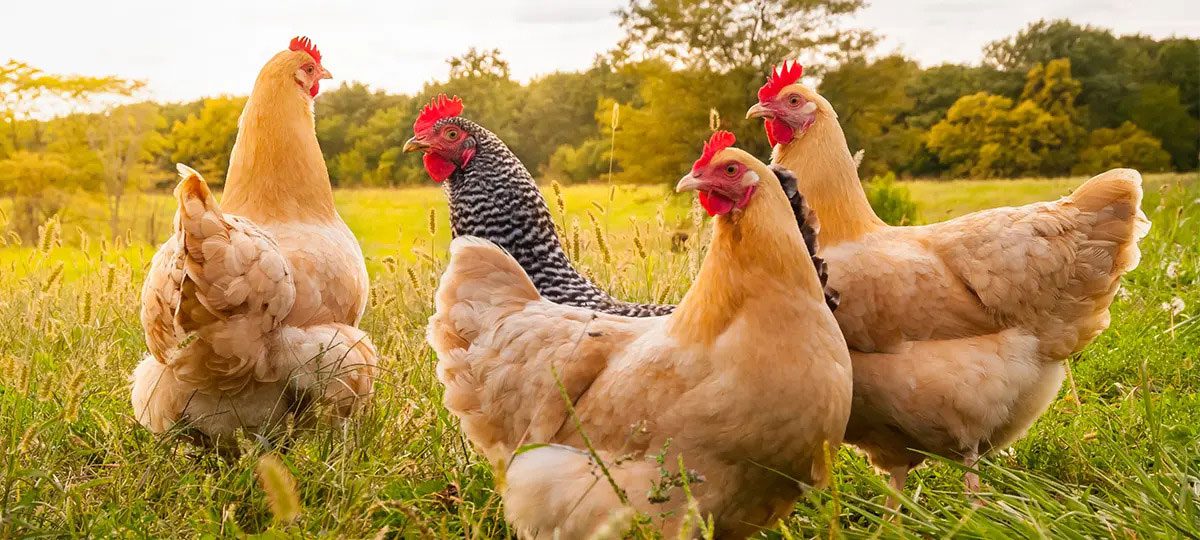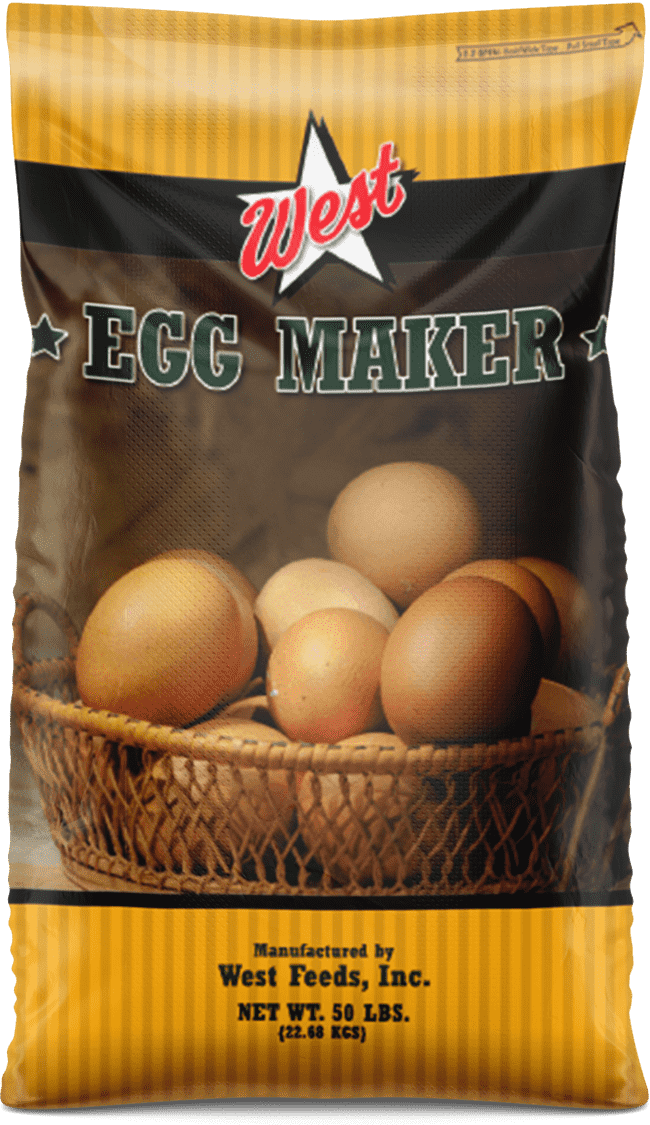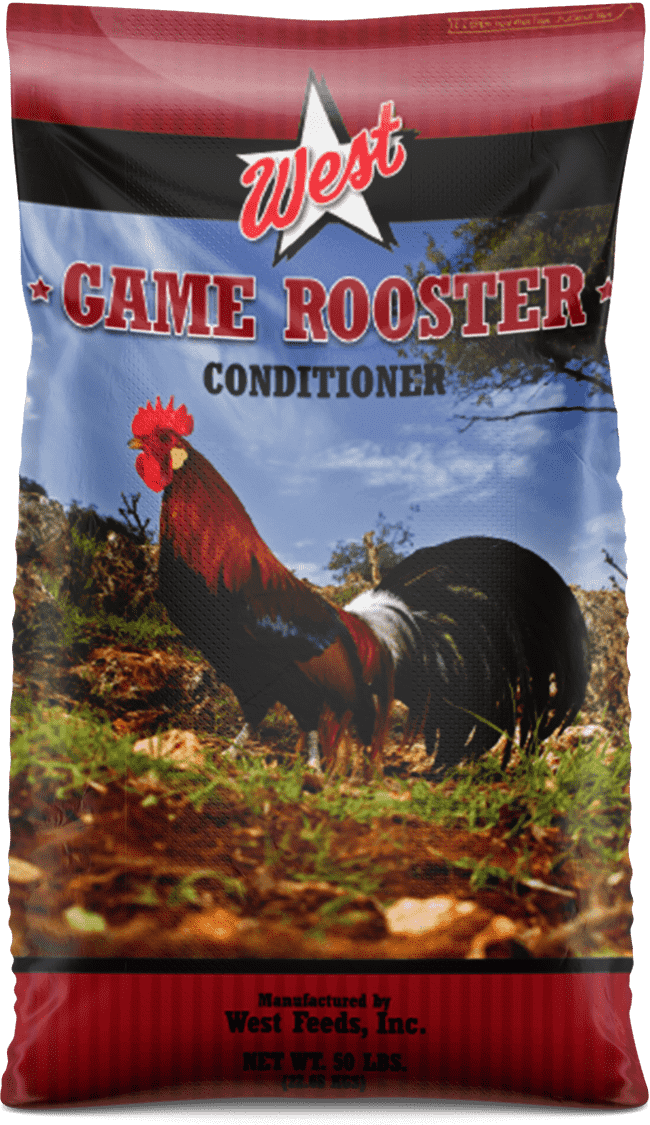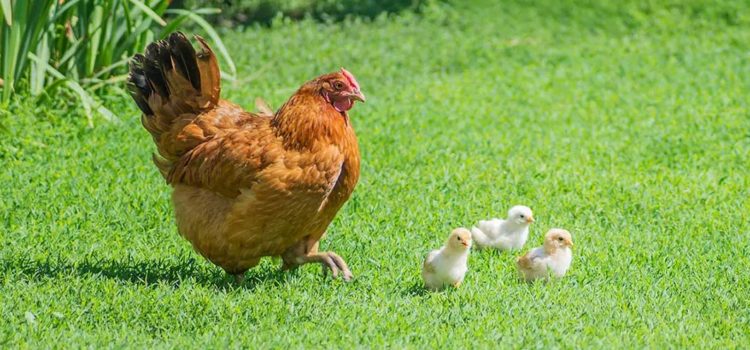Have you recently decided to raise chickens? If so, you may have questions like how to choose the right breed, what to feed chickens, and more. For the answers to those questions, read on.
Below we’ve got all the information you need to choose, feed, and care for backyard chickens and receive the many benefits of having your own flock.
Step 1: Do Your Due Diligence
Before investing in chickens and everything you need to keep them in your backyard, it’s vital to do your due diligence (aka homework.)
The last thing you want to do is spend a lot of money on chickens, feed, coops, and everything else and then find out that you’re not allowed to have them in your town, subdivision, or municipality.
For example, some towns and cities have a “no livestock” clause in their charter, banning anyone from having chickens within their city limits. Many don’t, but your particular subdivision and HOA might not allow backyard chickens, which would put the kibosh on the entire project.
Again, a little due diligence might save you from a lot of headaches.
Step 2: Decide what You Want From Your Chickens
Before starting, knowing what you want from your backyard chicken project is critical because different chickens provide different things.
Some chickens are best for laying eggs, while others are better for providing a protein source. If you want eggs, the former is better than the latter. Of course, you might also want both eggs and protein, in which case you need to prepare for that.
Here are a few more examples to help you make these decisions before you start buying chickens and equipment:
- If you want eggs, egg fertilization isn’t necessary, and thus a rooster isn’t required either. (Hens can lay perfect eggs without a rooster.)
- If you want to have chicks or have fertile eggs, you’ll need to get a rooster as well as hens. The rule of thumb is one rooster for every dozen hens (which is a convenient coincidence, we think you’ll agree).
- Shell color is different depending on the hens you purchase. There’s white, of course, but also brown, green, and blue.
- Do you want chickens with yellow or white skin? They have both, so you need to know.
- For more breast meat or dark meat, you’ll need a particular breed of chicken.
- Do you think you’ll get more chickens in the future? If yes, planning your coop and space ahead of time could save you time, money, and effort later.
- Are full-sized chickens what you seek, or smaller bantam chickens that eat less feed (but produce less meat)?
As you can see, there are a lot of questions you need to answer before you even get started and long before you buy your very first backyard chicken.

Step 3: The Different Types and Classifications of Chickens
Before purchasing your first chicken, it’s a good idea to know a little bit more about the different breeds and varieties of chicken. Chickens are generally classified by color, shape, size, and origin, but there are many other ways to classify them.
Active or Passive Breeds
Active breed foragers are the best type of chicken if you plan to have a free-range backyard chicken operation with lots of pasture. Less active breeds don’t forage nearly as much and will instead wait to be fed every day.
What about Climate?
Climate is also an essential factor when raising backyard chickens. Some chickens do much better in colder areas, while others are better acclimated in areas where the temperatures get hot.
The size of a chicken’s comb can help you decide. In hotter regions, chickens with large combs typically do well, while those with smaller ones do better in the cold.
A good rule of thumb is that American breeds are better if you live in a colder climate, while Mediterranean breeds are best if you live in a hot environment.
Class, Breed, and Variety
Chickens are separated into different classes based on geographical region. If you’re looking at their body shape and size, skin color, feathering, and toes, that usually refers to the breed.
Different feather colors and patterns, and various types of combs, usually refers to the variety of chicken.
An excellent example of this is the leghorn variety of chicken, as there are brown and white varieties of leghorn. If you go far enough back, you’ll find that all chickens originated in southeast Asia from the red and green jungle fowl breed popular there.
Temperament
The temperament of the chickens you purchase is also important—this is more or less how the chicken acts, with some being more aggressive or docile than other breeds. Some are also more nervous than others, all of which can impact your experience raising backyard chickens.
For example, if your children will be helping you, docile and friendly breeds of chicken are probably the best.
Egg-Laying Chickens
It probably won’t surprise you to know that some chicken breeds have been bred to do very well at egg-laying. Indeed, some of the best can lay between 250 to 300 eggs a year, which is impressive.
However, egg layers aren’t a good choice if you’re looking for meat/protein chickens. That’s because egg layers are generally smaller, grow more slowly, and have less meat than chickens bred to provide protein. (One good thing is that they eat less feed and thus could save you some money in the long run.)
Most chicken experts agree that Leghorns are the best at laying eggs, although several other breeds do well also. However, since Leghorns put all their time and effort into egg-laying, they aren’t outstanding meat producers.
Egg Colors and Nutrition Content with Egg Laying Chickens
The eggs your chickens lay can come in several different colors, as we mentioned earlier. That includes the typical white as well as various shades of brown, green, and blue.
One thing to note, though, is that the nutritional content or taste of the eggs you get has nothing to do with the color of the shell. There’s no difference between the nutrition content of brown eggs and white eggs. The determining factor for an egg’s nutrition content is the diet given to the chicken, not the color of the shell.

You might’ve noticed that brown eggs cost more at the store. That’s because brown eggs are (usually) larger and come from larger hens that need more feed to stay healthy.
White eggs are typically laid by smaller hens that require less feed. That’s why white eggs are more popular at the grocery store because commercial egg producers save a lot of money on their feed. (The cost increase or decrease is passed down to the consumer.)
The best chicken breeds for egg-laying include:
- Leghorn
- Rhode Island Red
- Ameraucana
- Orpington
- Plymouth Rock
- Silkie
- Wyandotte
- Sussex
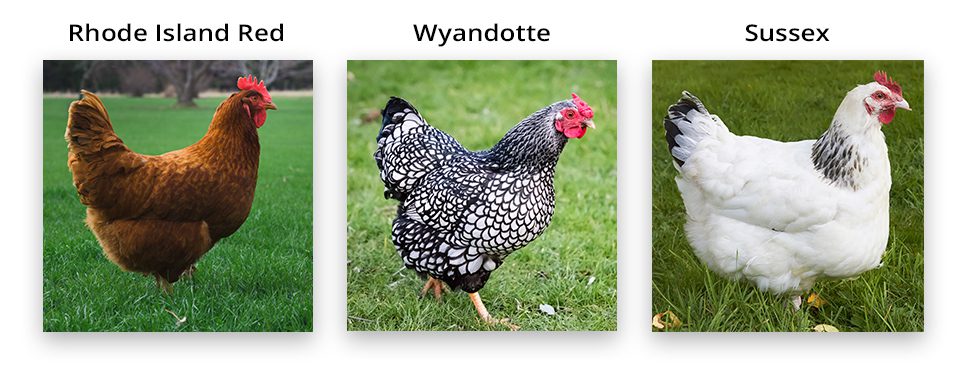
Meat Producing Chicken Varieties
If you’re looking for chickens that will provide a good protein (meat) source, there are certain breeds you need to look at.
Genetic selection is the key to developing a chicken that grows fast and produces more breast meat. These chickens have been bred over many generations to be much bigger and grow much quicker than the typical egg-laying breed of chicken.
One caveat is that meat-producing chickens are generally poor egg-laying chickens and provide far fewer eggs.
Some of the most popular chickens for protein include:
- Cornish Cross
- Jersey Giant
- Bresse
- Orpington
- Java
- Freedom Ranger
- Naked Neck

Dual-Purpose Chicken Varieties
If chickens good at producing both eggs and meat are what you want, choosing a dual-purpose chicken breed is your best choice. Indeed, dual-purpose chickens are the most popular among backyard chicken enthusiasts because they provide both.
One thing to keep in mind is that a chicken’s egg production and growth are reversely correlated. If you have a chicken that produces eggs well, it will likely not make as much meat and vice versa.
The good news is that several breeds of chickens have been bred for dual-purpose reasons and do an excellent job at balancing egg production with meat production.
Some of the most popular dual-purpose chicken breeds include:
- Rhode Island Red
- Dominique
- Brahma
- Wyandotte
- Delaware
- Orpington
- Plymouth Rock
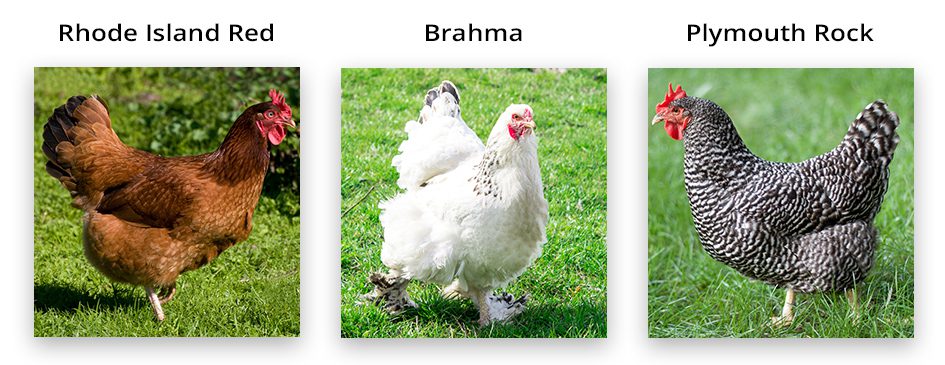
Feeding Your Backyard Chickens
Now that you know more about the different breeds, it’s time to talk about the different types of chicken feed.
When it comes to raising chickens, one crucial factor to keep in mind is that their feed represents about 70% of the overall cost to support them. Also, if you want the maximum egg or meat productivity, your chickens will need an adequate diet with the proper nutrients. The right diet is typically based on the age of your chickens and what you want them to provide; meat, eggs, or both.
Six nutrient categories are the most important, including:
- Water
- Carbohydrates
- Fat
- Protein
- Vitamins
- Minerals
To ensure that your chickens get the required nutrition, chicken experts recommend mixing their feed which, frankly, can be a complex process. That’s why most backyard chicken owners purchase high-quality commercial feed from a local feed store.
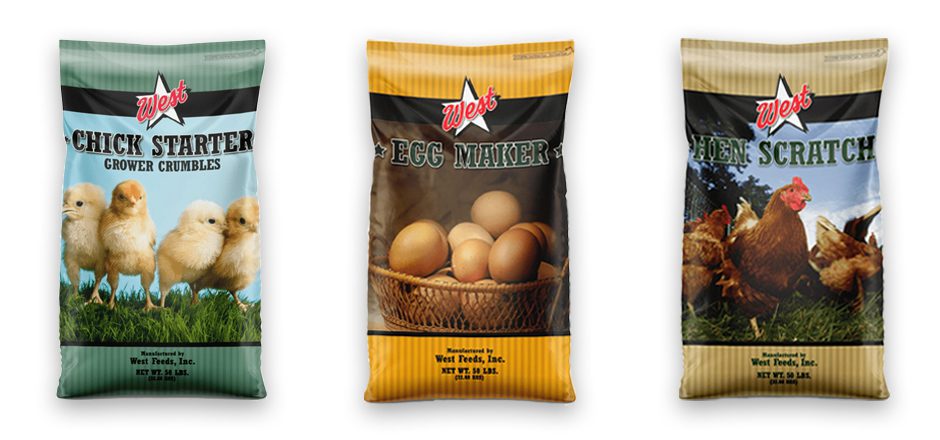
Poor Nutrition = Poor Quality Eggs and Meat
Feed is essential when it comes to raising backyard chickens. For example, veterinarians in diagnostic laboratories have found that nutritional deficiencies cause most chicken diseases. Those diseases include nutritional coryza, rickets, curly toe paralysis, etc. Again, most of these problems are from improper nutrition and, frankly, generally seen when a homeowner is feeding their chickens a mix of feed they made themselves.
Different Types of Chicken Feed based on Age and Need
When you first start shopping for chicken feeds for your birds, you’ll find that there are several options available. There are chick starter feeds, complete hen layer feeds, and poultry grain mix rations.
The correct ration depends on several factors, including the age of your chickens and whether they’re a pullet, a layer, or a broiler.
It would be best if you never fed layer rations to young chickens. The high calcium level in a layer diet can cause improper bone formation in young chickens, kidney failure, and even death. Also, starter and grower rations shouldn’t be fed to chickens that will produce eggs. The eggshell quality of a laying hen, if fed a broiler start a diet, can be extremely poor.
Many problems caused by inadequate nutrition, especially in young, growing chickens, are typically irreversible, so you need to get it right from the very beginning. Many people who raise backyard chickens try to save money but, in the end, end up causing themselves more problems due to unhealthy chickens.
Different Forms of Chicken Feed
Typically, commercial poultry feed comes in three different types; mash, crumble, and pellet.
Mash is usually the least expensive because it cost more to process feed into pellet or crumble form. That being said, pellets and crumbles offer several advantages over mash. For example, your chickens can consume more feed in pellet form and metabolize it more easily. They can’t pick out individual feed ingredients and thus get a more well-rounded diet. Handling pellets is also more manageable, and there’s much less waste.
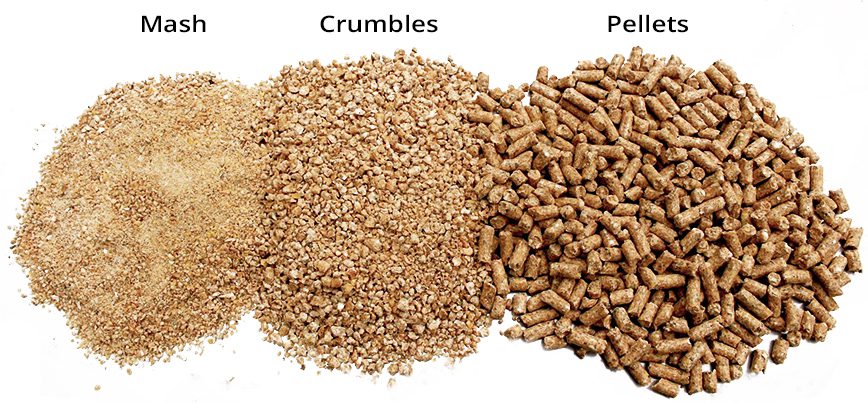
Feed Handling
No matter the type or form of feed you give to your backyard chickens, it’s imperative that you handle it correctly so that it retains its nutrient value. The fact is, when chicken feed is held or stored for an extended time, the nutrients in it can break down and become ineffective.
Feed Storage
It is absolutely imperative that you store your chicken feed in a clean, dry area protected from rodents, insects, and other vermin. Also, avoid storing bags of feed on a concrete floor as the moisture from the concrete can be transferred to the feed and ruin it.
Experts recommend storing chicken feed bags in a plastic trash can with a tightly sealed lid. You can also store them on a wooden pallet which allows air to circulate under the bags and keep the feed inside dry.
Medicated Chicken Feed
Unfortunately, preventing diseases in your backyard chickens is something that is usually necessary to keep them healthy.
Most feeds are available today in medicated and nonmedicated form, with the medicated form containing a drug, coccidiostat, that prevents coccidiosis. Coccidiosis is caused by an intestinal parasite. Thankfully, if one or more of your chickens has endured and recovered from coccidiosis, caused by a particular strain of this protozoa, they develop a resistance or immunity to that strain and will not get sick from it again.
If you are selling your chickens at the market for their meat, you should stop using feed with a coccidiostat in it several days ahead of time. It’s imperative that you read the label on your chicken feed to know what to do. Many coccidiostats need to be withdrawn from chickens several days before the birds can be marketed. However, some coccidiostats do not have to be withdrawn because they do not accumulate in the body tissue of poultry. Also, avoid feeding coccidiostats to hens laying eggs.
As with any other type of living creature, your backyard chickens need access to fresh, clean water every day. As we’ve seen, they also need access to the correct feed and the proper level of nutrients to remain healthy and provide high-quality eggs and meat.

Final Thoughts
There are many excellent benefits to be derived from having your own backyard chicken flock. For starters, chickens are enjoyable and interesting creatures that are quite amusing in their own right. Also, they provide pest control by eating many different types of insects found in the grass.
Backyard chickens produce delicious eggs and meat, and their excrement (poop) makes a perfect fertilizer for the garden. Many children have been involved with 4-H and FFA projects over the years involving chickens, an excellent way to provide them with a more comprehensive education in handling animals and their benefits.
Of course, raising and keeping backyard chickens requires a good bit of effort on the part of their owner. As we mentioned at the beginning of this article, you need to plan and know what your ultimate goal will be before you start. That includes making sure that your town, city, neighborhood, or HOA allows you to keep chickens in your backyard.
Providing a safe place for your chickens to roost, lay eggs, and grow is also vital, especially if you live in an area with many predators. It’s also imperative that you realize your backyard chickens will need care 365 days a year, including on the weekends and during holidays. If you are going to be gone for several days or weeks, it’s crucial you find someone trustworthy and dependable to take care of them in your absence.
We wish you the very best of luck with your new chicken endeavor.
Hopefully, the information we’ve provided today will allow you to raise your chickens well and take advantage of all of the excellent benefits that having backyard chickens provides.

